Showing posts with label Tourism 旅游. Show all posts
Showing posts with label Tourism 旅游. Show all posts
Monday, December 16, 2024
Tuesday, December 20, 2022
Tuesday, March 24, 2020
Extends suspension for foreigners entering country
Vietnam extends suspension for foreigners entering country
Vietnam said it will temporarily suspend entry to all foreigners who already have travel visas to the country, except for those visiting the country for diplomatic or official purposes, amid the coronavirus outbreak.
Foreigners who are deemed experts, business managers or highly skilled workers will still be allowed to enter the country but must have certificates indicating they have tested negative for the virus, must fill out health declarations and will be ordered into quarantine upon arrival, the government said in a statement on Sunday (March 22).
The entry suspension will also apply to foreign nationals who are ethnic Vietnamese, and who normally can travel to Vietnam visa-free, according to the posting.
Vietnam on last Wednesday suspended issuing visas for travellers from all countries for 30 days, except for those entering the country for diplomatic or business purposes.
Prime Minister Nguyen Xuan Phuc is ordering additional quarantine buildings to house 20,000 people in Hanoi, according to a separate statement. He also ordered limiting international flights, without elaborating.
~The Straits Times~
Vietnam said it will temporarily suspend entry to all foreigners who already have travel visas to the country, except for those visiting the country for diplomatic or official purposes, amid the coronavirus outbreak.
Foreigners who are deemed experts, business managers or highly skilled workers will still be allowed to enter the country but must have certificates indicating they have tested negative for the virus, must fill out health declarations and will be ordered into quarantine upon arrival, the government said in a statement on Sunday (March 22).
The entry suspension will also apply to foreign nationals who are ethnic Vietnamese, and who normally can travel to Vietnam visa-free, according to the posting.
Vietnam on last Wednesday suspended issuing visas for travellers from all countries for 30 days, except for those entering the country for diplomatic or business purposes.
Prime Minister Nguyen Xuan Phuc is ordering additional quarantine buildings to house 20,000 people in Hanoi, according to a separate statement. He also ordered limiting international flights, without elaborating.
~The Straits Times~
Monday, November 25, 2019
Macaque island draws tourists – and criticism
Vietnam macaque island draws tourists – and criticism

Monkeys cling to a tourist at Monkey Island in Nha Trang, central Vietnam. There are about 1,200 macaques on the small island, where vaccine experiments were once carried out by Soviet scientists before it was transformed into a tourist attraction in the 1990s. NHAC NGUYEN/afp
Menacing macaques snatch bags of crisps, water bottles, cookies and crackers from uneasy tourists on Vietnam’s Monkey Island, a popular attraction decried as cruel by activists calling for an end to animal tourism in Southeast Asia.
Tourists are encouraged to show the monkeys their empty hands if they don’t want to be accosted by the aggressive macaques, who routinely steal snacks, hats, and even mobile phones from visitors, who nervously laugh and snap pictures.
“They grabbed my biscuits and climbed on my body,” Dinh Thi Hoa said on the small island in Nha Phu bay in south-central Vietnam.
“I didn’t even have time to open my bag, the monkey took it from me and opened it!” she said, smiling, after a gang of macaques rifled through her rucksack.
It is one of countless animal tourism sites across Vietnam where for just a few dollars visitors can ride elephants or ostriches, or see costumed bears and tigers perform at circuses.
Over on Monkey Island, macaques ride motorbikes, lift weights and shoot basketballs in their own packed circus performance that ends with a monkey in a frilly skirt collecting tips from the audience.
Elsewhere on the island, visitors eagerly place bets on a monkey swimming race to close out a morning of animal entertainment.
It’s cruel work, according to some.
“Monkeys don’t choose to walk on their hind legs, ride bikes, or perform other meaningless and humiliating tricks – they’ve simply learned to fear what will happen if they don’t,” said Jason Baker, animal rights group Peta’s vice president of international campaigns.
“Travel companies and tourists must stop buying tickets to cruel exhibits like Monkey Island,” he added.
There are about 1,200 macaques on the small island, where vaccine experiments were once carried out by Soviet scientists before it was transformed into a tourist attraction in the 1990s.
Monkey Island manager Truong Nguyen Phuoc An says the animals are never beaten, and are well looked after thanks to tourist dollars.
“We can have money to maintain the island and buy more food for the monkeys,” he told AFP, as tourists boarded boats under a searing midday sun.
Throngs of visitors stream though every week, mostly Vietnamese, Chinese and Russians who jet across the bay from the beach resort hotspot Nha Trang.
Many are happy to see the monkeys, brushing aside claims the animals should be left alone.
“I think they are well-fed and happy, it’s perfect,” said Kirill, a 19-year-old visitor from Russia.
~Phnom Penh Post~

Monkeys cling to a tourist at Monkey Island in Nha Trang, central Vietnam. There are about 1,200 macaques on the small island, where vaccine experiments were once carried out by Soviet scientists before it was transformed into a tourist attraction in the 1990s. NHAC NGUYEN/afp
Menacing macaques snatch bags of crisps, water bottles, cookies and crackers from uneasy tourists on Vietnam’s Monkey Island, a popular attraction decried as cruel by activists calling for an end to animal tourism in Southeast Asia.
Tourists are encouraged to show the monkeys their empty hands if they don’t want to be accosted by the aggressive macaques, who routinely steal snacks, hats, and even mobile phones from visitors, who nervously laugh and snap pictures.
“They grabbed my biscuits and climbed on my body,” Dinh Thi Hoa said on the small island in Nha Phu bay in south-central Vietnam.
“I didn’t even have time to open my bag, the monkey took it from me and opened it!” she said, smiling, after a gang of macaques rifled through her rucksack.
It is one of countless animal tourism sites across Vietnam where for just a few dollars visitors can ride elephants or ostriches, or see costumed bears and tigers perform at circuses.
Over on Monkey Island, macaques ride motorbikes, lift weights and shoot basketballs in their own packed circus performance that ends with a monkey in a frilly skirt collecting tips from the audience.
Elsewhere on the island, visitors eagerly place bets on a monkey swimming race to close out a morning of animal entertainment.
It’s cruel work, according to some.
“Monkeys don’t choose to walk on their hind legs, ride bikes, or perform other meaningless and humiliating tricks – they’ve simply learned to fear what will happen if they don’t,” said Jason Baker, animal rights group Peta’s vice president of international campaigns.
“Travel companies and tourists must stop buying tickets to cruel exhibits like Monkey Island,” he added.
There are about 1,200 macaques on the small island, where vaccine experiments were once carried out by Soviet scientists before it was transformed into a tourist attraction in the 1990s.
Monkey Island manager Truong Nguyen Phuoc An says the animals are never beaten, and are well looked after thanks to tourist dollars.
“We can have money to maintain the island and buy more food for the monkeys,” he told AFP, as tourists boarded boats under a searing midday sun.
Throngs of visitors stream though every week, mostly Vietnamese, Chinese and Russians who jet across the bay from the beach resort hotspot Nha Trang.
Many are happy to see the monkeys, brushing aside claims the animals should be left alone.
“I think they are well-fed and happy, it’s perfect,” said Kirill, a 19-year-old visitor from Russia.
~Phnom Penh Post~
Thursday, November 21, 2019
Festival highlights beautiful pink grass hills in Central Highlands
Festival highlights beautiful pink grass hills in Vietnam’s Central Highlands
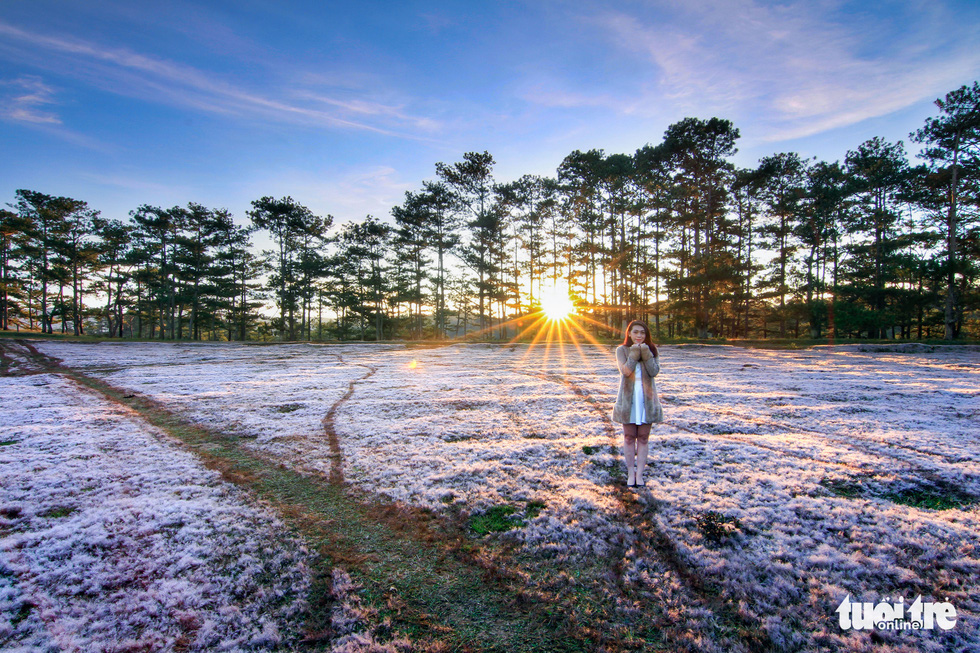
Pink grassland in the Dan Kia Lake – Golden Stream area, Lac Duong District, the Central Highlands province of Lam Dong. Photo: Dinh Van Bien /
Authorities in the Central Highlands province of Lam Dong have kick-started the 2019 Lang Biang Pink Grass Festival as pink grass once again takes over vast portions of local hills in Lac Duong District, creating an other-worldly scene.
As the rainy season comes to an end in Lam Dong and the dry season begins, the low temperature creates an ideal condition for a new generation of pink grass to engulf hilltops throughout several locations in the Dan Kia Lake – Golden Stream area.
Each blade of the grass is home to hundreds of tiny flowers which bloom into a collection of soft pink snowflakes each morning when the sun peaks over the mountaintops and casts light on tiny dewdrops that has been frozen on the grass.
The fantastic scene, considered one of the most beautiful of the year in the Central Highlands province, has made the area a famous photography spot for visitors.

Pink grassland in the Dan Kia Lake – Golden Stream area, Lac Duong District, the Central Highlands province of Lam Dong. Photo: Dinh Van Bien / Tuoi Tre
The local administration in Lac Duong District has taken advantage of the location’s unusual landscape to establish an annual festival with the aim of boosting tourism.
The Lang Biang Pink Grass Festival, which is in its third edition this year, offers visitors a series of activities besides snapping photos with the pink grass, such as traditional music performances, folk games, and a horse race.
In addition to the Dan Kia Lake – Golden Stream area, other locations such as Trai Mat and Thai Phien in Da Lat City, the capital city of Lam Dong, also boast similar pink grasslands.
Below are photos capturing the pink grass scene in Dan Kia Lake – Golden Stream taken by a Tuoi Tre (Youth) newspaper contributor.
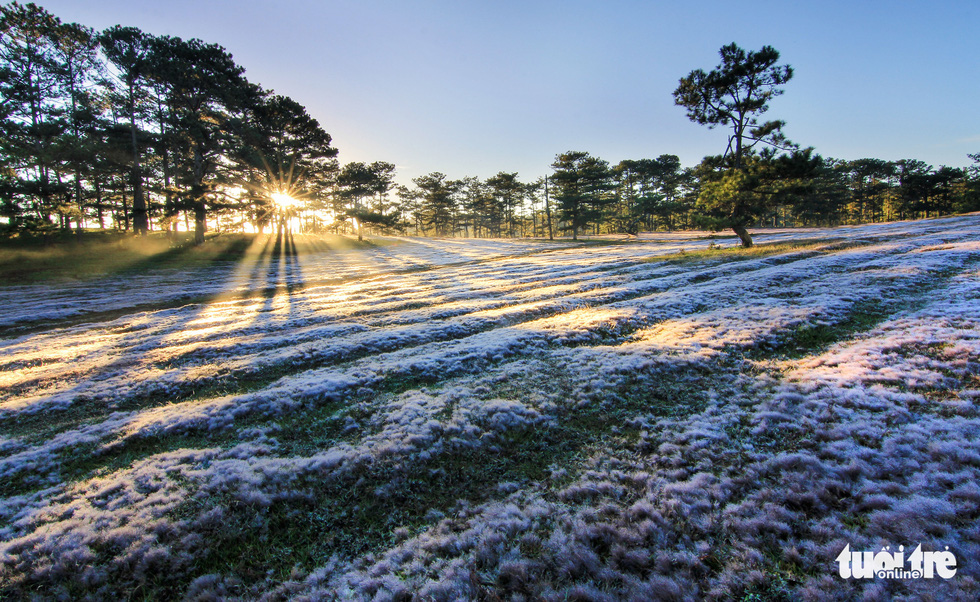
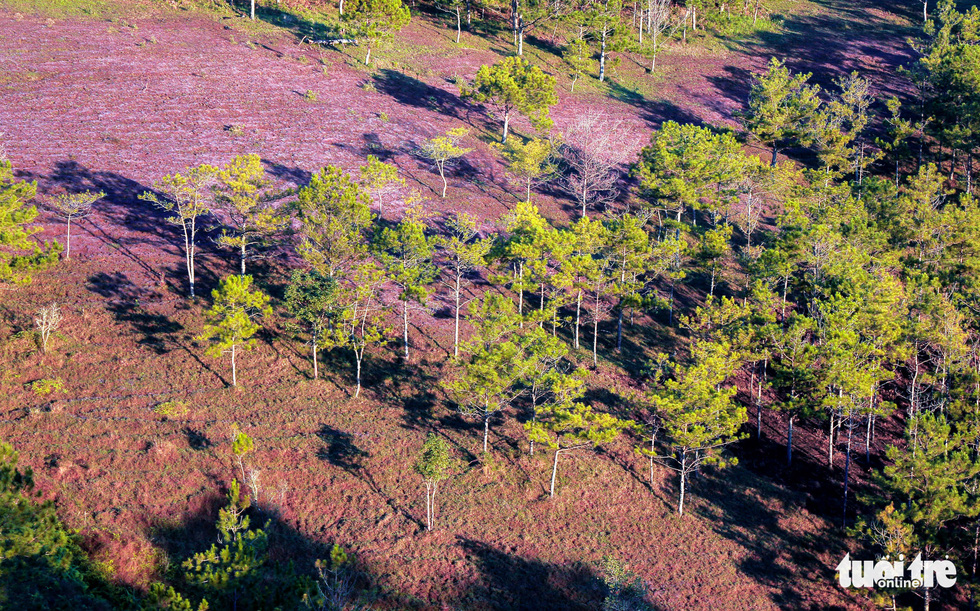

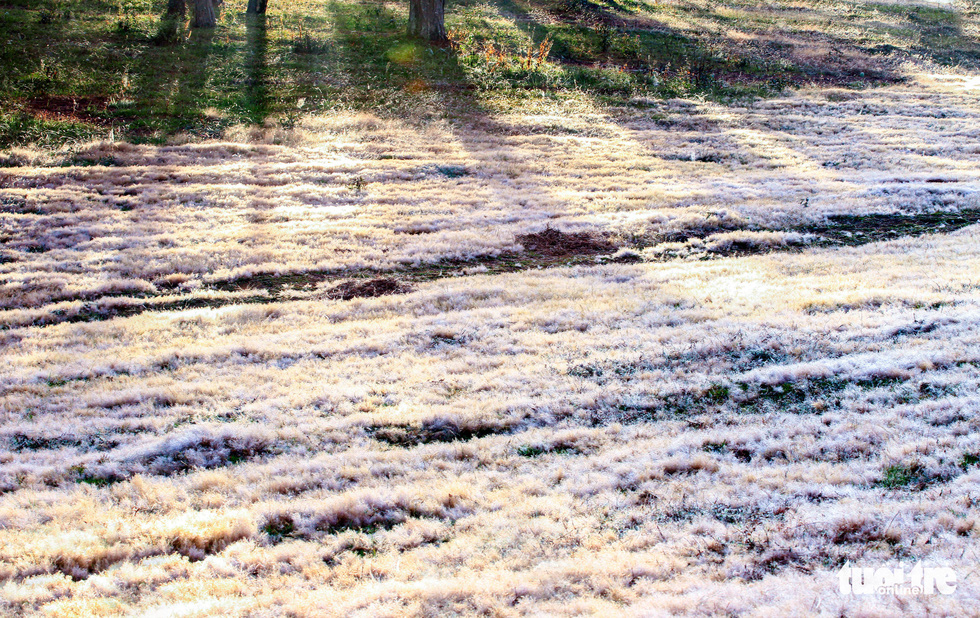
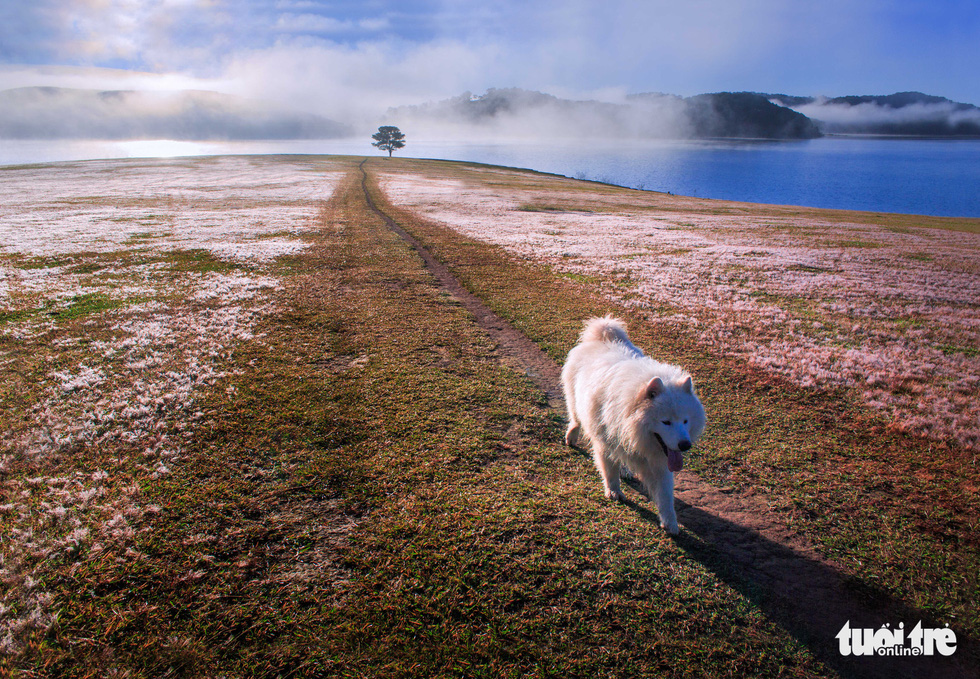

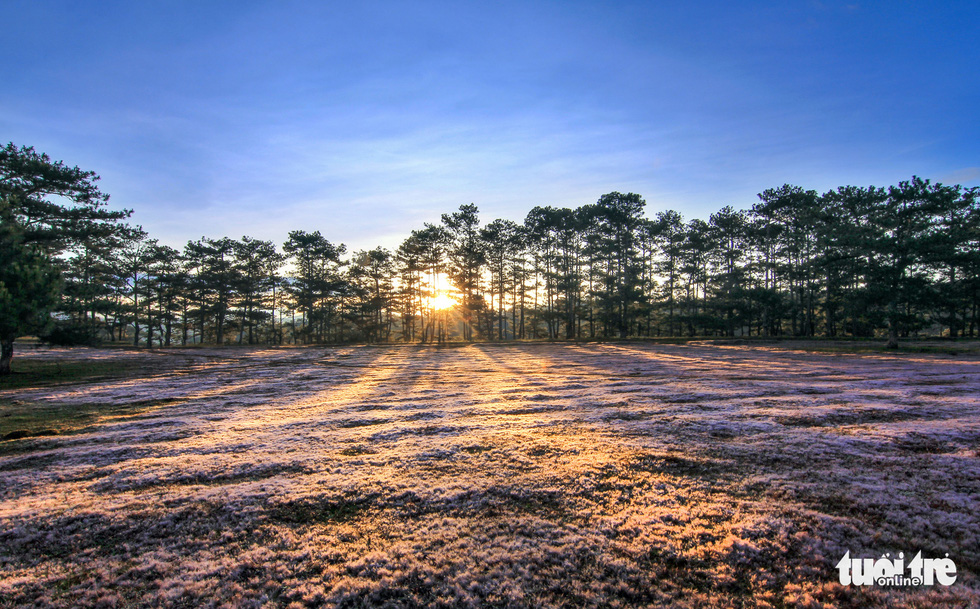
~Tuoi Tre News~

Pink grassland in the Dan Kia Lake – Golden Stream area, Lac Duong District, the Central Highlands province of Lam Dong. Photo: Dinh Van Bien /
Authorities in the Central Highlands province of Lam Dong have kick-started the 2019 Lang Biang Pink Grass Festival as pink grass once again takes over vast portions of local hills in Lac Duong District, creating an other-worldly scene.
As the rainy season comes to an end in Lam Dong and the dry season begins, the low temperature creates an ideal condition for a new generation of pink grass to engulf hilltops throughout several locations in the Dan Kia Lake – Golden Stream area.
Each blade of the grass is home to hundreds of tiny flowers which bloom into a collection of soft pink snowflakes each morning when the sun peaks over the mountaintops and casts light on tiny dewdrops that has been frozen on the grass.
The fantastic scene, considered one of the most beautiful of the year in the Central Highlands province, has made the area a famous photography spot for visitors.

Pink grassland in the Dan Kia Lake – Golden Stream area, Lac Duong District, the Central Highlands province of Lam Dong. Photo: Dinh Van Bien / Tuoi Tre
The local administration in Lac Duong District has taken advantage of the location’s unusual landscape to establish an annual festival with the aim of boosting tourism.
The Lang Biang Pink Grass Festival, which is in its third edition this year, offers visitors a series of activities besides snapping photos with the pink grass, such as traditional music performances, folk games, and a horse race.
In addition to the Dan Kia Lake – Golden Stream area, other locations such as Trai Mat and Thai Phien in Da Lat City, the capital city of Lam Dong, also boast similar pink grasslands.
Below are photos capturing the pink grass scene in Dan Kia Lake – Golden Stream taken by a Tuoi Tre (Youth) newspaper contributor.







~Tuoi Tre News~
Monday, April 9, 2018
Tuesday, February 20, 2018
Monday, February 12, 2018
Friday, February 9, 2018
Friday, January 12, 2018
HCMC to hold fireworks shows to mark New Year, Tet
Ho Chi Minh City to hold fireworks shows to mark New Year, Tet
A high-range show and several low-range displays will be organized during the festive occasions
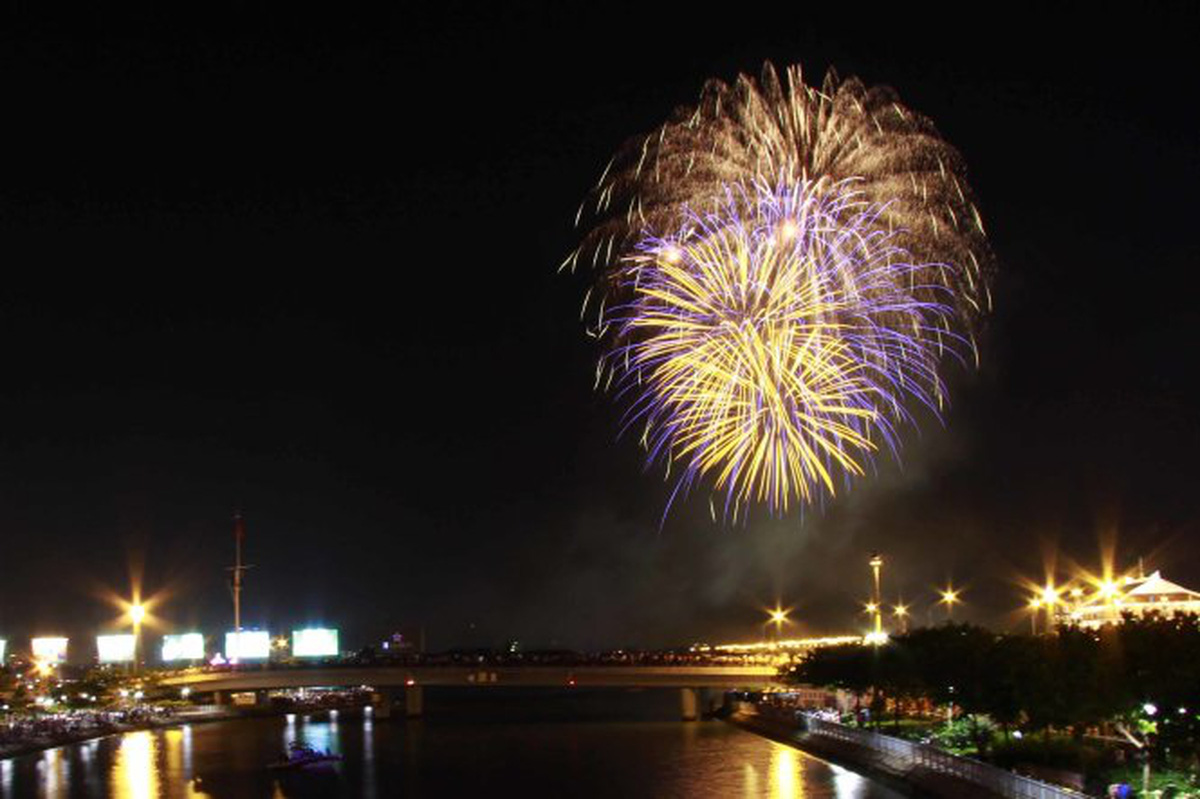
A fireworks performance is pictured in Ho Chi Minh City. Photo: Tuoi Tre
The central government has given a go-ahead for authorities in Ho Chi Minh City to organize fireworks displays in celebration of the New Year and upcoming Tet (Lunar New Year).
The Government Office has sent a document to the Ministry of Culture, Sports and Tourism and the Ho Chi Minh City People’s Committee, green-lighting pyrotechnic shows to be held in the southern metropolis on New Year’s Eve and Lunar New Year’s Eve.
A high-range pyrotechnic exhibition will take place in District 2 near the Thu Thiem Tunnel on New Year’s Eve.
Three low-range performances will be given at the Dam Sen Park in District 11, Cu Chi Tunnels in the namesake outlying district, and Rung Sac Square in Can Gio District.
The much-awaited performances will start at midnight and last for 15 minutes.
A similar plan has also been approved for Lunar New Year’s Eve, which falls on the night of February 15, along with two extra low-range fireworks shows at the Nga Ba Giong Memorial in Hoc Mon District and a location in Nha Be District.
Expenditures for the shows must not be funded by the state budget and safety procedures must be strictly adhered to, the Government Office stressed.
The municipal People’s Committee had earlier submitted a document to Prime Minister Nguyen Xuan Phuc to secure his approval for pyrotechnic displays for the special occasions, which will be funded by the private sector.
~News courtesy of Tuoi Tre News~
A high-range show and several low-range displays will be organized during the festive occasions

A fireworks performance is pictured in Ho Chi Minh City. Photo: Tuoi Tre
The central government has given a go-ahead for authorities in Ho Chi Minh City to organize fireworks displays in celebration of the New Year and upcoming Tet (Lunar New Year).
The Government Office has sent a document to the Ministry of Culture, Sports and Tourism and the Ho Chi Minh City People’s Committee, green-lighting pyrotechnic shows to be held in the southern metropolis on New Year’s Eve and Lunar New Year’s Eve.
A high-range pyrotechnic exhibition will take place in District 2 near the Thu Thiem Tunnel on New Year’s Eve.
Three low-range performances will be given at the Dam Sen Park in District 11, Cu Chi Tunnels in the namesake outlying district, and Rung Sac Square in Can Gio District.
The much-awaited performances will start at midnight and last for 15 minutes.
A similar plan has also been approved for Lunar New Year’s Eve, which falls on the night of February 15, along with two extra low-range fireworks shows at the Nga Ba Giong Memorial in Hoc Mon District and a location in Nha Be District.
Expenditures for the shows must not be funded by the state budget and safety procedures must be strictly adhered to, the Government Office stressed.
The municipal People’s Committee had earlier submitted a document to Prime Minister Nguyen Xuan Phuc to secure his approval for pyrotechnic displays for the special occasions, which will be funded by the private sector.
~News courtesy of Tuoi Tre News~
HCMC to open second book street in 2018
Ho Chi Minh City to open second book street in 2018
Visitors to the second book street in Ho Chi Minh City can peruse their purchases and sip coffee at a book café nearby
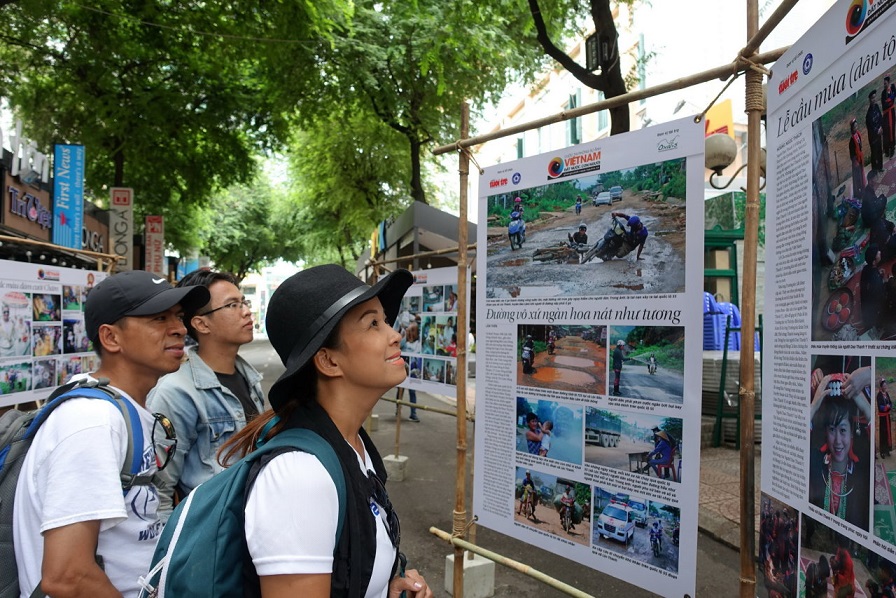
Visitors review entries of Tuoi Tre (Youth) newspaper’s photo exhibition at the gallery at Nguyen Van Binh Book Street, Ho Chi Minh City. Photo: Tuoi Tre Ho Chi Minh City’s second book street, to be located in District 7, is expected to become another cultural rendezvous for urbanites and promote the reading culture.
The municipal People’s Committee has ratified a project to build the city’s second book street on Nguyen Dong Chi Street in Tan Phu Ward.
The venue, named after Nguyen Dong Chi, a revered folk culture researcher, is expected to open in 2018.
The municipal administration has tasked the District 7 People’s Committee with implementing the project using funds contributed by the private sector.
Investment in the street, which will boast 20 richly-decorated stalls and a coffee shop, is estimated at nearly VND14 billion (US$ 614,731).
Representatives of the Vietnam Publishers Association’s Ho Chi Minh City office revealed the city was planning to set up a book street in each of its districts in a bid to promote the reading culture.
According to a survey recently conducted by the Ho Chi Minh City Book Street Management, over 58 percent of the 450 respondents said they went to the book street to buy printed publications, while 36 percent of them affirmed they were drawn to the venue to read books.
The poll also found sightseeing and sipping drinks as purposes among nearly 50 percent and 19 percent of the respondents.
The survey findings confirmed the necessity of launching a book street in densely populated areas, which is also in line with current trends.
The future rendezvous will adopt the same model as that of Nguyen Van Binh Book Street in downtown areas, which opened in January 2016 to the delight of avid readers and publishers.
Lined with old trees providing lush foliage, Nguyen Van Binh Book Street spans 144m and 8m in length and width, and boasts sidewalks which are 6m wide.
Apart from 19 book stalls, other highlights are an exhibition space and a book café, situated next to the Saigon Central Post Office, one of Ho Chi Minh City's icons, which is a perfect place for visitors to skim their newly-bought books and sip their coffee while delighting in the beauty of the heart of the southern metropolis.
The street has emerged as a favorite hang-out for local residents, voracious young readers and expats on weekends.
Alongside Nguyen Van Binh and Nguyen Dong Chi Book Streets, city authorities have also planned to launch three other book streets in other districts, with the third venue likely to be located in District 5.
Speaking at The Sofa, a monthly book-themed discussion group held on Nguyen Van Binh Book Street in December 2016, Le Hoang, deputy chairman of the Vietnam Publishers Association, said while more books have been printed in Vietnam over the years, it remains an issue that few Vietnamese are fond of reading.
Hoang said textbooks and school reference books accounted for as many as 80 percent of the books available on the market.
“The reading rate amongst Vietnamese is only one book per person per year if we exclude these two types of books,” he said.
The Vietnamese only spend $2 a year on books, compared to $10 by the Chinese and upwards of $200 for those in developed countries, Hoang added.
~News courtesy of Tuoi Tre News~
Visitors to the second book street in Ho Chi Minh City can peruse their purchases and sip coffee at a book café nearby

Visitors review entries of Tuoi Tre (Youth) newspaper’s photo exhibition at the gallery at Nguyen Van Binh Book Street, Ho Chi Minh City. Photo: Tuoi Tre Ho Chi Minh City’s second book street, to be located in District 7, is expected to become another cultural rendezvous for urbanites and promote the reading culture.
The municipal People’s Committee has ratified a project to build the city’s second book street on Nguyen Dong Chi Street in Tan Phu Ward.
The venue, named after Nguyen Dong Chi, a revered folk culture researcher, is expected to open in 2018.
The municipal administration has tasked the District 7 People’s Committee with implementing the project using funds contributed by the private sector.
Investment in the street, which will boast 20 richly-decorated stalls and a coffee shop, is estimated at nearly VND14 billion (US$ 614,731).
Representatives of the Vietnam Publishers Association’s Ho Chi Minh City office revealed the city was planning to set up a book street in each of its districts in a bid to promote the reading culture.
According to a survey recently conducted by the Ho Chi Minh City Book Street Management, over 58 percent of the 450 respondents said they went to the book street to buy printed publications, while 36 percent of them affirmed they were drawn to the venue to read books.
The poll also found sightseeing and sipping drinks as purposes among nearly 50 percent and 19 percent of the respondents.
The survey findings confirmed the necessity of launching a book street in densely populated areas, which is also in line with current trends.
The future rendezvous will adopt the same model as that of Nguyen Van Binh Book Street in downtown areas, which opened in January 2016 to the delight of avid readers and publishers.
Lined with old trees providing lush foliage, Nguyen Van Binh Book Street spans 144m and 8m in length and width, and boasts sidewalks which are 6m wide.
Apart from 19 book stalls, other highlights are an exhibition space and a book café, situated next to the Saigon Central Post Office, one of Ho Chi Minh City's icons, which is a perfect place for visitors to skim their newly-bought books and sip their coffee while delighting in the beauty of the heart of the southern metropolis.
The street has emerged as a favorite hang-out for local residents, voracious young readers and expats on weekends.
Alongside Nguyen Van Binh and Nguyen Dong Chi Book Streets, city authorities have also planned to launch three other book streets in other districts, with the third venue likely to be located in District 5.
Speaking at The Sofa, a monthly book-themed discussion group held on Nguyen Van Binh Book Street in December 2016, Le Hoang, deputy chairman of the Vietnam Publishers Association, said while more books have been printed in Vietnam over the years, it remains an issue that few Vietnamese are fond of reading.
Hoang said textbooks and school reference books accounted for as many as 80 percent of the books available on the market.
“The reading rate amongst Vietnamese is only one book per person per year if we exclude these two types of books,” he said.
The Vietnamese only spend $2 a year on books, compared to $10 by the Chinese and upwards of $200 for those in developed countries, Hoang added.
~News courtesy of Tuoi Tre News~
Wednesday, December 6, 2017
Wednesday, November 8, 2017
Ho Chi Minh City opens second ‘food street’
Ho Chi Minh City opens second ‘food street’
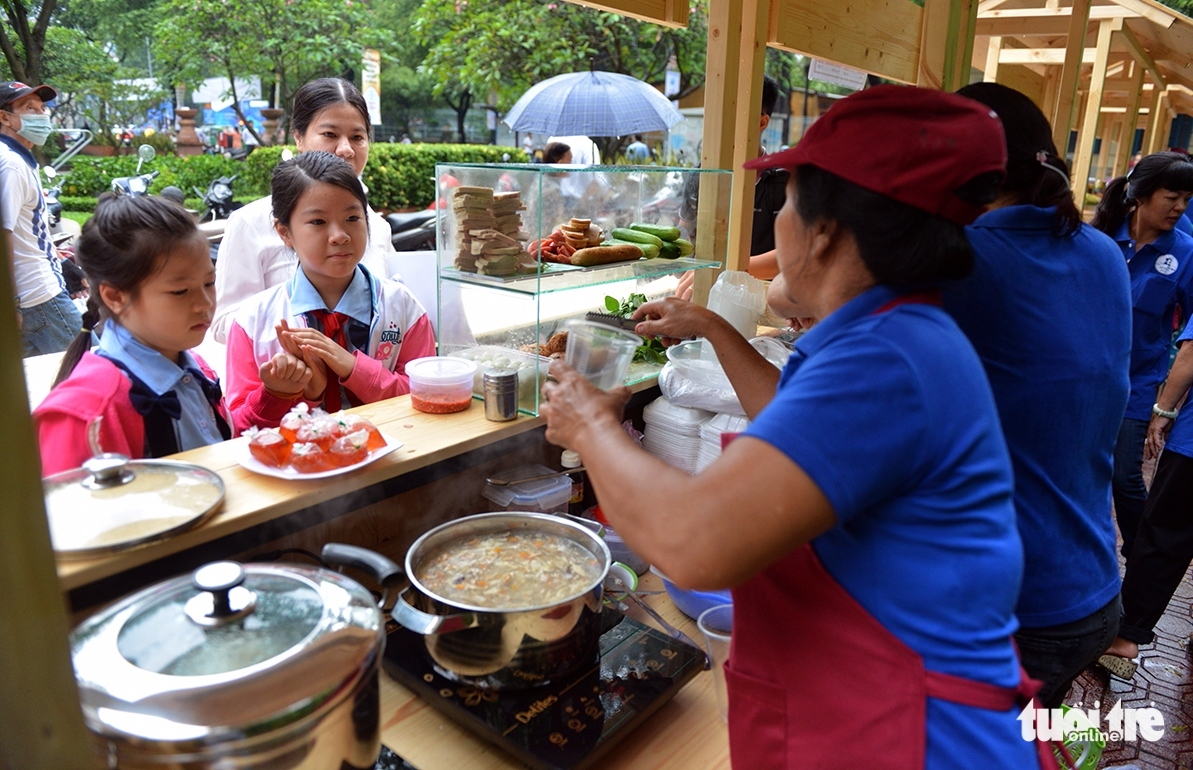
The Bach Diep Tung food street in District 1, Ho Chi Minh City. Photo: Tuoi Tre
A second ‘food street’ opened on Monday morning in Ho Chi Minh City, one month after the launch of the first.
The new food hub is located at the Bach Tung Diep Park in District 1, bordered by Nam Ky Khoi Nghia and Ly Tu Trong Streets.
The 30-meter food street houses up to 30 catering businesses run by former street vendors, who take turns to occupy the stalls in two shifts: between 6:00 am and 9:00 am, and from 11:00 am to 2:00 pm.
The food street is the second of its kind to be opened in the southern metropolis, following a months-long crackdown on sidewalk-encroaching street vendors headed by Doan Ngoc Hai, deputy chairman of District 1.
The city’s first food street was launched on August 28 along Nguyen Van Chiem Street, which lies between the Youth Culture House and Diamond Plaza, connecting Pham Ngoc Thach and Hai Ba Trung Streets in District 1.
While the Nguyen Van Chiem food street only offers takeaways, there are tables and parasols available at the Bach Tung Diep food street for diners to enjoy their meal nearby.
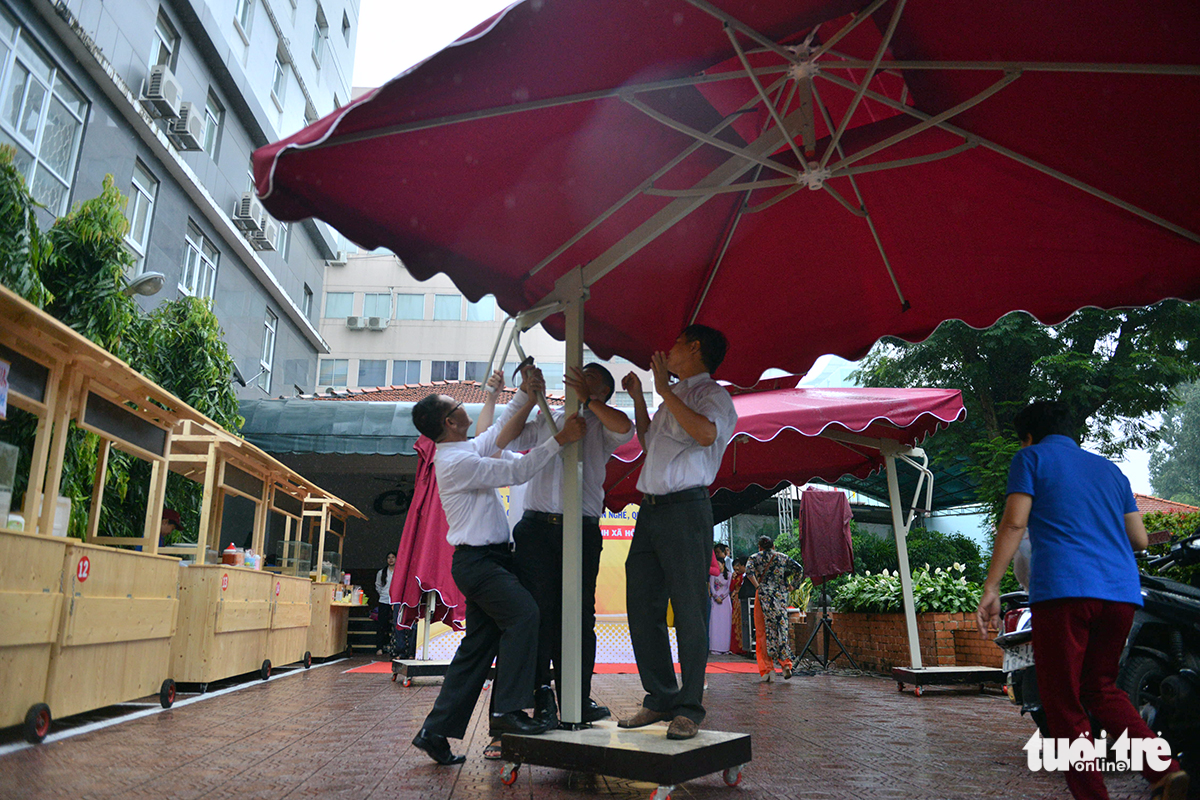
Parasols and tables are available for diners to enjoy their meal on the spot. Photo: Tuoi Tre Food safety and hygiene are the number-one priorities a both streets, with all vendors undergoing a compulsory training course, according to Tran The Thuan, chairman of District 1.
Doan Ngoc Hai was present at the opening day of the Bach Tung Diep food street on Monday morning to hand out lucky money and wish the vendors a profitable year.
A representative from District 1’s administration said the district would permit night shifts in the near future to meet the varied demands of diners in the city.
The sidewalk clearance campaign began earlier this year after Hai took it upon himself to enforce the district’s often-ignored sidewalk occupancy laws.
Taking note of the campaign’s positive reception from local citizens, other neighborhoods in Ho Chi Minh City had begun following suit until the initiative came to a sudden end in late March.
Hai marked the campaign’s return with a surprise crackdown on August 9, issuing fines to multiple cars and taxis parked illegally on sidewalks and confiscating tables and chairs from eateries occupying the pavements.
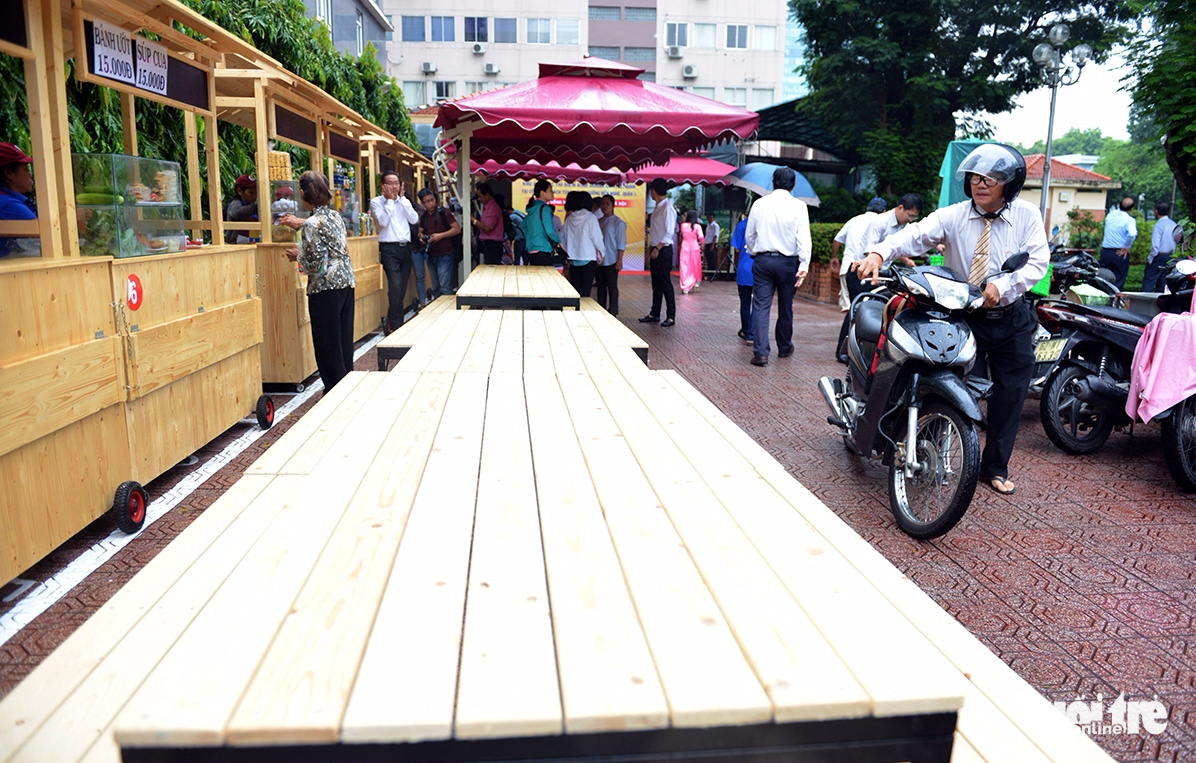
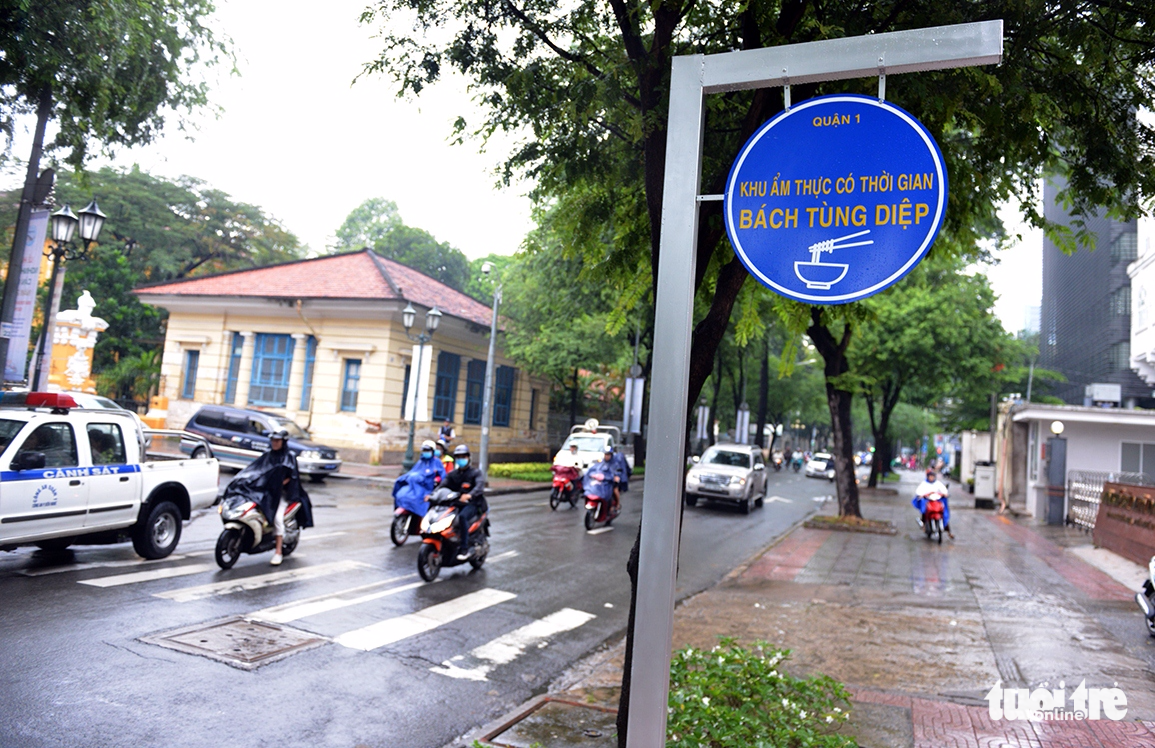
The Bach Tung Diep food street in District 1, Ho Chi Minh City. Photo: Tuoi Tre
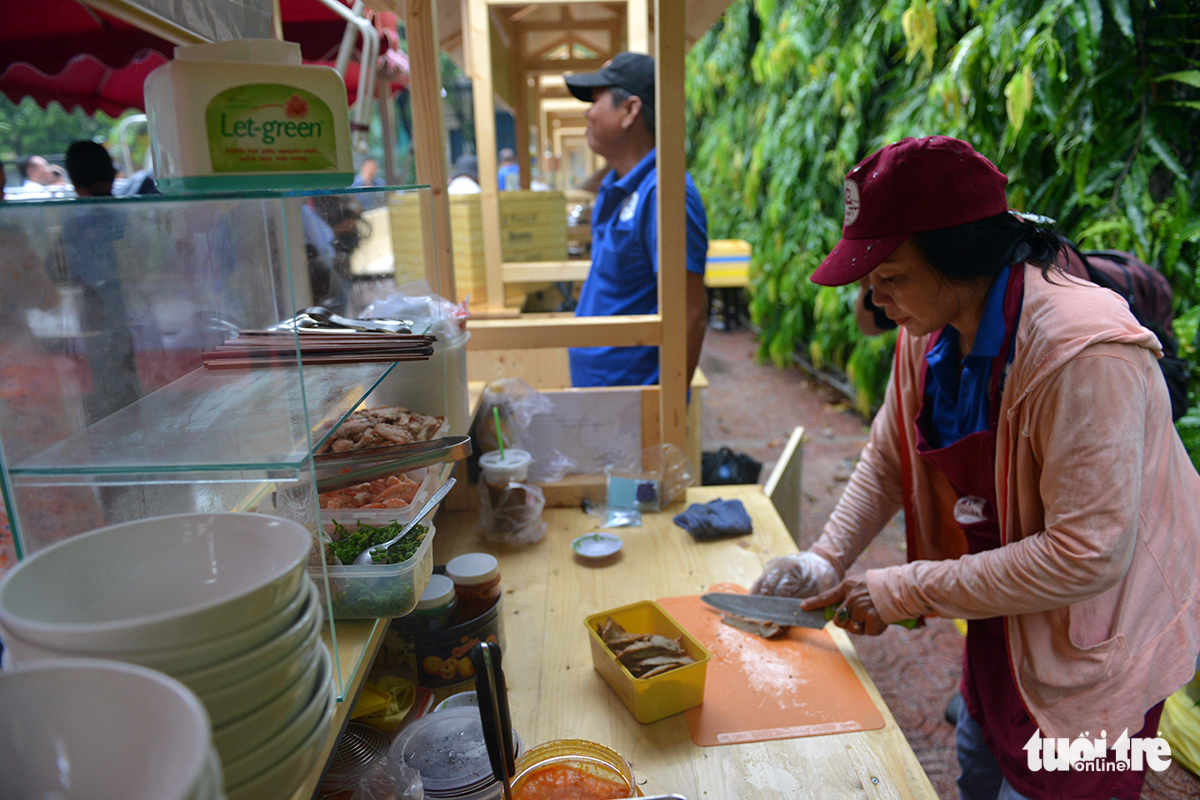
A vendor prepares food at the Bach Tung Diep food street in District 1, Ho Chi Minh City. Photo: Tuoi Tre
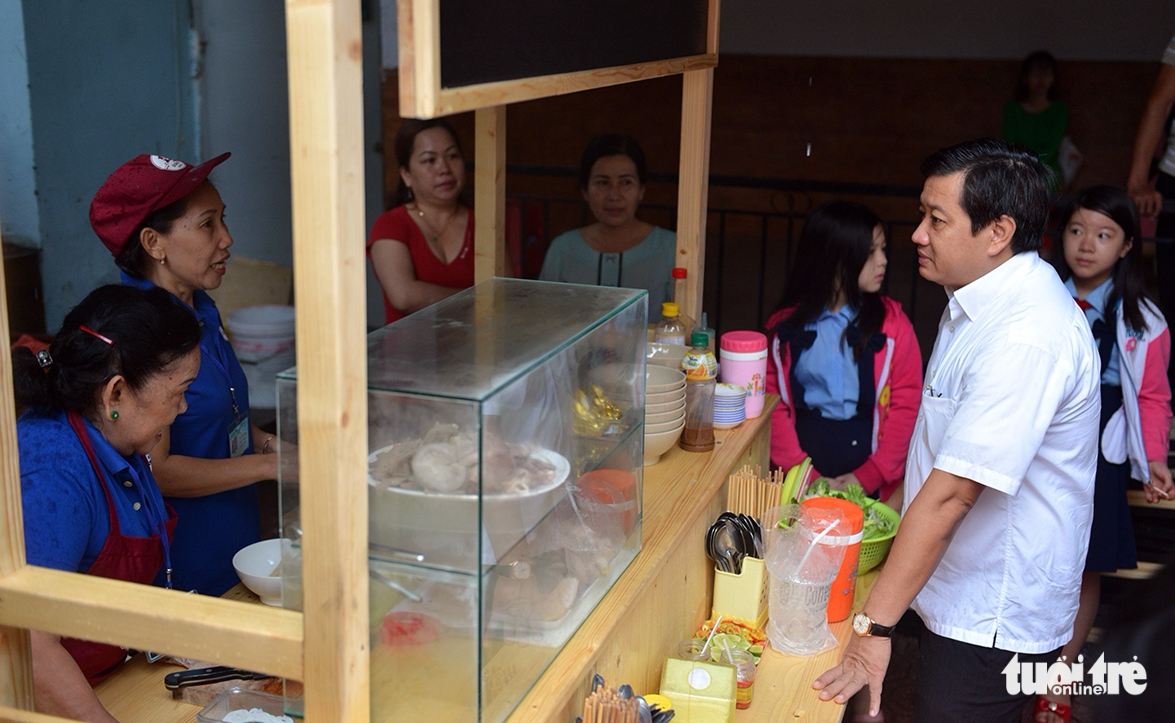
Doan Ngoc Hai, deputy chairman of District 1, talks with vendors at the Bach Tung Diep food street on the opening day, October 2, 2017. Photo:
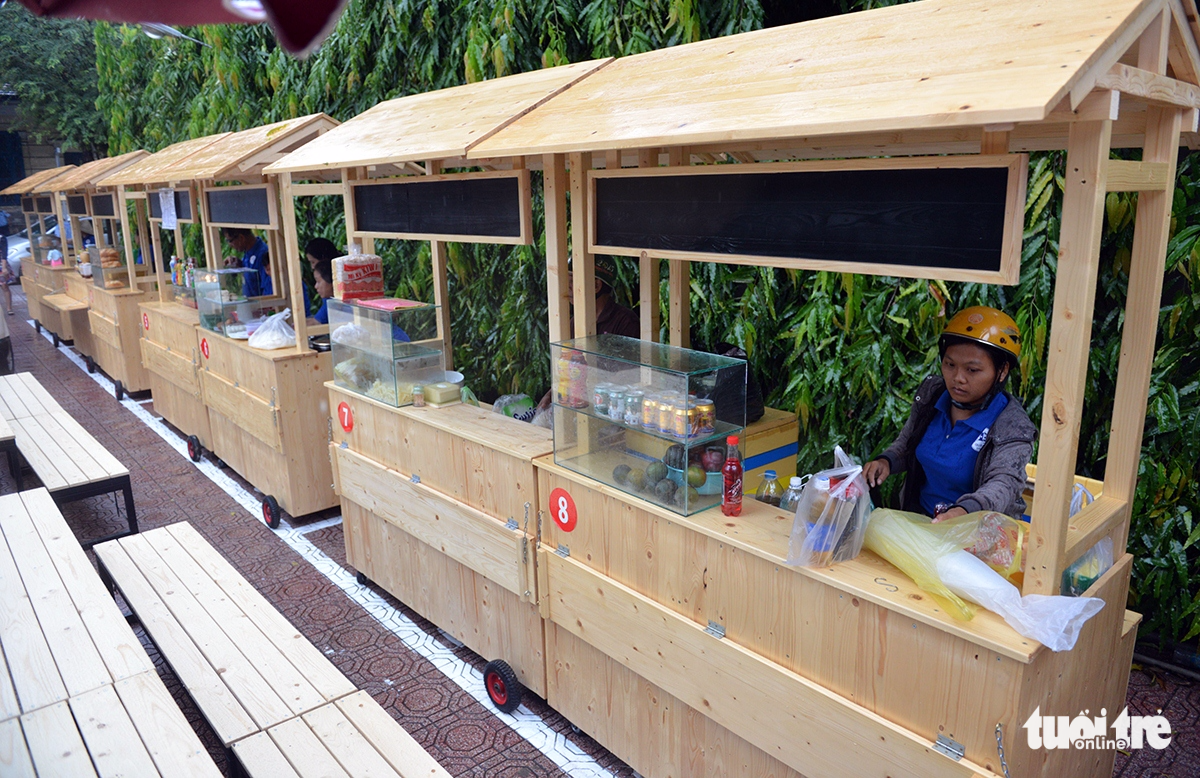
Wooden stalls are used at the Bach Tung Diep food street in District 1, Ho Chi Minh City. Photo: Tuoi Tre
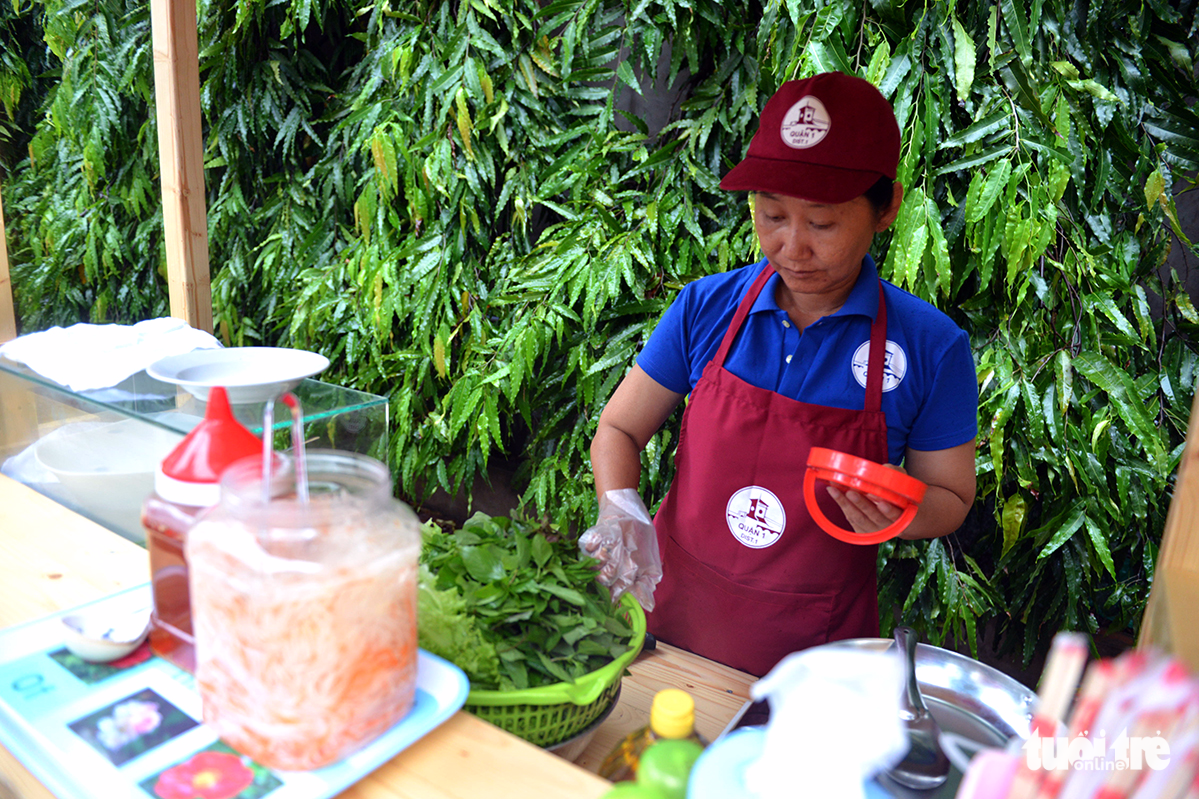
A vendor prepares food at the Bach Tung Diep food street in District 1, Ho Chi Minh City. Photo: Tuoi Tre
~News courtesy of Tuoi Tre~

The Bach Diep Tung food street in District 1, Ho Chi Minh City. Photo: Tuoi Tre
A second ‘food street’ opened on Monday morning in Ho Chi Minh City, one month after the launch of the first.
The new food hub is located at the Bach Tung Diep Park in District 1, bordered by Nam Ky Khoi Nghia and Ly Tu Trong Streets.
The 30-meter food street houses up to 30 catering businesses run by former street vendors, who take turns to occupy the stalls in two shifts: between 6:00 am and 9:00 am, and from 11:00 am to 2:00 pm.
The food street is the second of its kind to be opened in the southern metropolis, following a months-long crackdown on sidewalk-encroaching street vendors headed by Doan Ngoc Hai, deputy chairman of District 1.
The city’s first food street was launched on August 28 along Nguyen Van Chiem Street, which lies between the Youth Culture House and Diamond Plaza, connecting Pham Ngoc Thach and Hai Ba Trung Streets in District 1.
While the Nguyen Van Chiem food street only offers takeaways, there are tables and parasols available at the Bach Tung Diep food street for diners to enjoy their meal nearby.

Parasols and tables are available for diners to enjoy their meal on the spot. Photo: Tuoi Tre Food safety and hygiene are the number-one priorities a both streets, with all vendors undergoing a compulsory training course, according to Tran The Thuan, chairman of District 1.
Doan Ngoc Hai was present at the opening day of the Bach Tung Diep food street on Monday morning to hand out lucky money and wish the vendors a profitable year.
A representative from District 1’s administration said the district would permit night shifts in the near future to meet the varied demands of diners in the city.
The sidewalk clearance campaign began earlier this year after Hai took it upon himself to enforce the district’s often-ignored sidewalk occupancy laws.
Taking note of the campaign’s positive reception from local citizens, other neighborhoods in Ho Chi Minh City had begun following suit until the initiative came to a sudden end in late March.
Hai marked the campaign’s return with a surprise crackdown on August 9, issuing fines to multiple cars and taxis parked illegally on sidewalks and confiscating tables and chairs from eateries occupying the pavements.


The Bach Tung Diep food street in District 1, Ho Chi Minh City. Photo: Tuoi Tre

A vendor prepares food at the Bach Tung Diep food street in District 1, Ho Chi Minh City. Photo: Tuoi Tre

Doan Ngoc Hai, deputy chairman of District 1, talks with vendors at the Bach Tung Diep food street on the opening day, October 2, 2017. Photo:

Wooden stalls are used at the Bach Tung Diep food street in District 1, Ho Chi Minh City. Photo: Tuoi Tre

A vendor prepares food at the Bach Tung Diep food street in District 1, Ho Chi Minh City. Photo: Tuoi Tre
~News courtesy of Tuoi Tre~
Đà Nẵng calls for tourism investment
Đà Nẵng calls for tourism investment

The Rồng (Dragon) Bridge spans the Hàn River. It is one of the most visited sites in Đà Nẵng. — VNS Photo Công Thành
At the APEC Summit, the central city of Đà Nẵng has called for investment in nine projects in tourism and entertainment worth an estimated US$500 million.
It says it wants the development done as Public-Private Partnerships (PPP) and Build-Own-Operate (BOO) models.
Deputy director of the city’s tourism department, Nguyễn Xuân Bình told Việt Nam News that the business forum was a big chance for the city’s tourism industry to show its power and potential for co-operation and investment.
He said a horse-racing project, planned on 500,000sq.m in Cẩm Lệ District, was the biggest project with a proposed investment capital of $200 million, while Ngũ Hành Sơn (Marble Mountains) Cultural and Historical Park has called for investment of $87 million.
Bình said the city also called for investment in the first underground shopping centre on Sơn Thuỷ Beach in coastal Ngũ Hành Sơn District with a proposed $40 million.
“We call for investment from foreign investors during our promotions in South Korea, Japan and Europe.
The city will ensure favourable conditions for investors with flexible policies and positive support as well as administrative reform,” Bình said.
“The city also has an eye on calling local and foreign investment in a cruise port and piers, public parks, an international cuisine centre and a dog-race arena,” he said.
Bình said the projects would help turn the city into a centre of tourism, shopping and finance in central Việt Nam as well as a rendezvous of UNESCO-recognised world heritage features such as Huế Monument Complex, Hội An Town and Mỹ Sơn Sanctuary in Quảng Nam Province; and Phong Nha-Kẻ Bàng National Park and Sơn Đoòng Cave in Quảng Bình Province.
According to the Đà Nẵng Investment Promotion and Support Agency, Đà Nẵng has attracted 43 new foreign direct investment (FDI) projects worth $60 million in the first eight months this year, 4.6 times the amount for the same period last year.
The city now has 461 FDI projects worth more than $3.6 billion, mostly in tourism, services, property and industry.
Đà Nẵng encourages investors in high-tech industries and high-quality services in the form of public-private partnerships (PPP), as well as investment in waste treatment, infrastructure development, and solar and wind power.
Earlier this year, the city listed 68 PPP projects, 22 of them in the high-tech sector.
From 2017-20, the city plans to attract investment worth $1.4 billion from domestic and foreign businesses.
~News courtesy of Viet Nam News~

The Rồng (Dragon) Bridge spans the Hàn River. It is one of the most visited sites in Đà Nẵng. — VNS Photo Công Thành
At the APEC Summit, the central city of Đà Nẵng has called for investment in nine projects in tourism and entertainment worth an estimated US$500 million.
It says it wants the development done as Public-Private Partnerships (PPP) and Build-Own-Operate (BOO) models.
Deputy director of the city’s tourism department, Nguyễn Xuân Bình told Việt Nam News that the business forum was a big chance for the city’s tourism industry to show its power and potential for co-operation and investment.
He said a horse-racing project, planned on 500,000sq.m in Cẩm Lệ District, was the biggest project with a proposed investment capital of $200 million, while Ngũ Hành Sơn (Marble Mountains) Cultural and Historical Park has called for investment of $87 million.
Bình said the city also called for investment in the first underground shopping centre on Sơn Thuỷ Beach in coastal Ngũ Hành Sơn District with a proposed $40 million.
“We call for investment from foreign investors during our promotions in South Korea, Japan and Europe.
The city will ensure favourable conditions for investors with flexible policies and positive support as well as administrative reform,” Bình said.
“The city also has an eye on calling local and foreign investment in a cruise port and piers, public parks, an international cuisine centre and a dog-race arena,” he said.
Bình said the projects would help turn the city into a centre of tourism, shopping and finance in central Việt Nam as well as a rendezvous of UNESCO-recognised world heritage features such as Huế Monument Complex, Hội An Town and Mỹ Sơn Sanctuary in Quảng Nam Province; and Phong Nha-Kẻ Bàng National Park and Sơn Đoòng Cave in Quảng Bình Province.
According to the Đà Nẵng Investment Promotion and Support Agency, Đà Nẵng has attracted 43 new foreign direct investment (FDI) projects worth $60 million in the first eight months this year, 4.6 times the amount for the same period last year.
The city now has 461 FDI projects worth more than $3.6 billion, mostly in tourism, services, property and industry.
Đà Nẵng encourages investors in high-tech industries and high-quality services in the form of public-private partnerships (PPP), as well as investment in waste treatment, infrastructure development, and solar and wind power.
Earlier this year, the city listed 68 PPP projects, 22 of them in the high-tech sector.
From 2017-20, the city plans to attract investment worth $1.4 billion from domestic and foreign businesses.
~News courtesy of Viet Nam News~
Sunday, September 17, 2017
AirAsia starts new route to Vietnam
AirAsia starts new route to Vietnam

New destination: (From second left) Lee, Fam and Nguyen at the inauguration of AirAsia’s latest route from Kuala Lumpur to Nha Trang.
AirAsia, Malaysia’s award-winning low-cost carrier, has launched its 54th unique route, Vietnam’s coastal city of Nha Trang.
The maiden flight, with a 93% flight load, landed at around noon (Vietnam time) on Thursday at Cam Ranh International Airport, greeted with a water cannon salute.
The inaugural flight was a milestone for AirAsia, being the first to operate direct flights to Nha Trang from Malaysia.
AirAsia Bhd commercial head Spencer Lee said 2017 has been an eventful year for Asean as it celebrates its 50th anniversary.
Also present were AirAsia director Datuk Fam Lee Ee and Khanh Hoa Department of Tourism vice-director Nguyen Thi Le Thanh.
Nha Trang is the capital of Khanh Hoa which lies along the coastline of south central Vietnam.
Lee said the daily direct flight from Kuala Lumpur to Nha Trang showed the carrier’s commitment to provide more connectivity between the two countries.
AirAsia also flies to other Vietnamese cities including Ho Chi Minh City, Da Nang and Hanoi.
Lee said passengers can use Fly-Thru, an optional baggage check-through service to their final destination without the hassle of immigration clearance at the transit hub.
With Fly-Thru service, passengers from 23 cities in eight countries can travel to Nha Trang seamlessly.
“We are confident that we will keep this route strong,” said Lee.
From now until Sept 24, AirAsia is offering RM99 all-in-fare one way to Nha Trang for travel until Feb 28 next year.
For more details, visit AirAsia on Twitter (twitter.com/AirAsia) and Facebook (facebook.com/AirAsia).
~News courtesy of The Star~

New destination: (From second left) Lee, Fam and Nguyen at the inauguration of AirAsia’s latest route from Kuala Lumpur to Nha Trang.
AirAsia, Malaysia’s award-winning low-cost carrier, has launched its 54th unique route, Vietnam’s coastal city of Nha Trang.
The maiden flight, with a 93% flight load, landed at around noon (Vietnam time) on Thursday at Cam Ranh International Airport, greeted with a water cannon salute.
The inaugural flight was a milestone for AirAsia, being the first to operate direct flights to Nha Trang from Malaysia.
AirAsia Bhd commercial head Spencer Lee said 2017 has been an eventful year for Asean as it celebrates its 50th anniversary.
Also present were AirAsia director Datuk Fam Lee Ee and Khanh Hoa Department of Tourism vice-director Nguyen Thi Le Thanh.
Nha Trang is the capital of Khanh Hoa which lies along the coastline of south central Vietnam.
Lee said the daily direct flight from Kuala Lumpur to Nha Trang showed the carrier’s commitment to provide more connectivity between the two countries.
AirAsia also flies to other Vietnamese cities including Ho Chi Minh City, Da Nang and Hanoi.
Lee said passengers can use Fly-Thru, an optional baggage check-through service to their final destination without the hassle of immigration clearance at the transit hub.
With Fly-Thru service, passengers from 23 cities in eight countries can travel to Nha Trang seamlessly.
“We are confident that we will keep this route strong,” said Lee.
From now until Sept 24, AirAsia is offering RM99 all-in-fare one way to Nha Trang for travel until Feb 28 next year.
For more details, visit AirAsia on Twitter (twitter.com/AirAsia) and Facebook (facebook.com/AirAsia).
~News courtesy of The Star~
Saturday, September 2, 2017
推动两国观光业‧越南办旅游路演
推动两国观光业‧越南办旅游路演

越南旅游部代表赠送纪念品予旅游部长唐坤(右)。(图:柬埔寨星洲日报)
为了进一步吸引更多国际游客,越南旅游部与越南驻我国大使馆于昨日在金边举办“越南旅游路演活动”,希望吸引更多第三个国家游客前来柬越两国观光。
受邀参加活动的旅游部长唐坤表示,2018年,我国政府將扩大大篷车游览(Caravan tour)项目规模,鼓励跨国边境旅游,提升两国旅游业发展,吸引更多第三个国家游客。
他说,柬越两国旅游多样化,南面的口岸与领海省份交接,是具有文化与歷史结合的旅游景点,因此建议两国共同开辟跨国沿海旅游路线。
他也呼吁,越南旅游业者踊跃参于今年11月17日至19日,在暹粒省举办的首届柬埔寨国际旅游展览(CTM),目前已报名参展的国家包括汶莱、马来西亚、缅甸、新加坡、泰国和菲律宾。 据越南旅游部表示,2016年,到越南观光的柬埔寨游客共21.2万人次,今年首7个月则为13.1万人次。
(柬埔寨星洲日报)

越南旅游部代表赠送纪念品予旅游部长唐坤(右)。(图:柬埔寨星洲日报)
为了进一步吸引更多国际游客,越南旅游部与越南驻我国大使馆于昨日在金边举办“越南旅游路演活动”,希望吸引更多第三个国家游客前来柬越两国观光。
受邀参加活动的旅游部长唐坤表示,2018年,我国政府將扩大大篷车游览(Caravan tour)项目规模,鼓励跨国边境旅游,提升两国旅游业发展,吸引更多第三个国家游客。
他说,柬越两国旅游多样化,南面的口岸与领海省份交接,是具有文化与歷史结合的旅游景点,因此建议两国共同开辟跨国沿海旅游路线。
他也呼吁,越南旅游业者踊跃参于今年11月17日至19日,在暹粒省举办的首届柬埔寨国际旅游展览(CTM),目前已报名参展的国家包括汶莱、马来西亚、缅甸、新加坡、泰国和菲律宾。 据越南旅游部表示,2016年,到越南观光的柬埔寨游客共21.2万人次,今年首7个月则为13.1万人次。
(柬埔寨星洲日报)
Friday, April 21, 2017
What tourists think about Vietnam
What tourists think about Vietnam
Although I’m finding it difficult to settle back into Vietnamese lifestyle after a short but emotionally draining trip to Australia, it’s nice to be back in the heat, noise, chaos, and unpredictability of this country. No two days are the same, it’s never boring, and it’s super cheap – I love it.
My three adult dogs are a bit wary of me, having been locked in the kennel for two weeks. They look at me as if to say ‘I don’t know what to think of you.’ I don’t blame them – there are truly times when I don’t know what to think about them either, especially after they chew up my bed. Why destroy something they love using? Double zap. Weird.
In an effort to chill out and shake the vacation blues for my Sydney trip, I went to a local pub for St. Patrick’s Day, an Irish celebration full of fun and music. There, I met a tourist couple keenly interested to know more about life in Vietnam – what really goes on here and how people live in a culture still very tightly focused on socialism despite the struggle to become a market economy. Questions over beer – that’s my forte.
There really does seem to be a gap between reality and what tourists experience in Vietnam. In Hoi An, where I live, it’s absolutely possible to interact with locals and experience the country while still enjoying Western comforts. Even so, we foreigners are often still clueless as to what locals think, believe, and practice in their lives, even after two weeks of touring.
What’s the average salary? How do people manage to survive? How do people get things done – particularly when dealing with the government? Why do they do this or that?
In my opinion, a real tour guide makes some attempt to answer these questions and give somewhat reliable background information on what the tourists see around them. I believe part of ensuring that tourists return to Vietnam is enabling them to get a better picture of what life here is all about – particularly for people who might want to settle, live, work, or just hang out for a while in Vietnam.
While chatting with the two tourists on St. Patrick’s Day, we covered topics such as the local health system, land ownership, the overwhelming extent of hotel and resort development, the idea of ‘service’ in cafés and offices, local salaries, and to what extent poverty exists in tourist towns like Hoi An.
On the whole, I find most tourists reasonably well informed of the history, geography, and ancient landmarks of Vietnam, yet totally in the dark when it comes to the local people around them.
A few fantastic tour groups targeting foreigners have made it a point to fill in the gaps about local life that make travelling enjoyable, giving tourists a far wider perspective on this gorgeous country and its infectiously cheerful population.
These companies seem aware that simply painting the nation in an unnaturally positive light, with tour guides rattling off facts and figures, runs the risk of aliening some visitors and boring others. In reality, introducing local features, such as the rivers and mountain landscapes, and incorporating a presentation on the pollution, water conservation issues, or deforestation that might be affecting these features are a way to create a serious connection with the country.
It also surprises me that guides don’t stop to show tourists how locals build houses, the costs and salaries involved, and issues relating to ownership. Guides also don’t seem to actually explain to their clients why there are so many sidewalk cafés and the necessity of locals to run a business with minimum paperwork. Showcasing Vietnam’s growing prosperity is one thing, but that highlight becomes fairly meaningless without appreciation for the country’s remaining poverty.
This might be a business niche for some youngsters to exploit. It could be called the ‘What’s it all about’ tour and involve driving down the back streets of a town followed by exploring a local village for contrast. I have a feeling this would be an excellent tourism product for the more inquisitive visitor wondering about life in Vietnam the 21st century.
Either way, a greater understanding of another culture’s faults and problems can be more useful in bridging connections between foreigners and Vietnam than a quick tour of the countryside with just enough time for a quick selfie and a stop for lunch before heading off to the next destination.
If travel was meant to broaden the mind, then we’ve missed an opportunity here. Perhaps in spreading knowledge about Vietnam, we can create new opportunities for locals and foreigners.
What do you think?
~Courtesy of Tuoi Tre~
Although I’m finding it difficult to settle back into Vietnamese lifestyle after a short but emotionally draining trip to Australia, it’s nice to be back in the heat, noise, chaos, and unpredictability of this country. No two days are the same, it’s never boring, and it’s super cheap – I love it.
My three adult dogs are a bit wary of me, having been locked in the kennel for two weeks. They look at me as if to say ‘I don’t know what to think of you.’ I don’t blame them – there are truly times when I don’t know what to think about them either, especially after they chew up my bed. Why destroy something they love using? Double zap. Weird.
In an effort to chill out and shake the vacation blues for my Sydney trip, I went to a local pub for St. Patrick’s Day, an Irish celebration full of fun and music. There, I met a tourist couple keenly interested to know more about life in Vietnam – what really goes on here and how people live in a culture still very tightly focused on socialism despite the struggle to become a market economy. Questions over beer – that’s my forte.
There really does seem to be a gap between reality and what tourists experience in Vietnam. In Hoi An, where I live, it’s absolutely possible to interact with locals and experience the country while still enjoying Western comforts. Even so, we foreigners are often still clueless as to what locals think, believe, and practice in their lives, even after two weeks of touring.
What’s the average salary? How do people manage to survive? How do people get things done – particularly when dealing with the government? Why do they do this or that?
In my opinion, a real tour guide makes some attempt to answer these questions and give somewhat reliable background information on what the tourists see around them. I believe part of ensuring that tourists return to Vietnam is enabling them to get a better picture of what life here is all about – particularly for people who might want to settle, live, work, or just hang out for a while in Vietnam.
While chatting with the two tourists on St. Patrick’s Day, we covered topics such as the local health system, land ownership, the overwhelming extent of hotel and resort development, the idea of ‘service’ in cafés and offices, local salaries, and to what extent poverty exists in tourist towns like Hoi An.
On the whole, I find most tourists reasonably well informed of the history, geography, and ancient landmarks of Vietnam, yet totally in the dark when it comes to the local people around them.
A few fantastic tour groups targeting foreigners have made it a point to fill in the gaps about local life that make travelling enjoyable, giving tourists a far wider perspective on this gorgeous country and its infectiously cheerful population.
These companies seem aware that simply painting the nation in an unnaturally positive light, with tour guides rattling off facts and figures, runs the risk of aliening some visitors and boring others. In reality, introducing local features, such as the rivers and mountain landscapes, and incorporating a presentation on the pollution, water conservation issues, or deforestation that might be affecting these features are a way to create a serious connection with the country.
It also surprises me that guides don’t stop to show tourists how locals build houses, the costs and salaries involved, and issues relating to ownership. Guides also don’t seem to actually explain to their clients why there are so many sidewalk cafés and the necessity of locals to run a business with minimum paperwork. Showcasing Vietnam’s growing prosperity is one thing, but that highlight becomes fairly meaningless without appreciation for the country’s remaining poverty.
This might be a business niche for some youngsters to exploit. It could be called the ‘What’s it all about’ tour and involve driving down the back streets of a town followed by exploring a local village for contrast. I have a feeling this would be an excellent tourism product for the more inquisitive visitor wondering about life in Vietnam the 21st century.
Either way, a greater understanding of another culture’s faults and problems can be more useful in bridging connections between foreigners and Vietnam than a quick tour of the countryside with just enough time for a quick selfie and a stop for lunch before heading off to the next destination.
If travel was meant to broaden the mind, then we’ve missed an opportunity here. Perhaps in spreading knowledge about Vietnam, we can create new opportunities for locals and foreigners.
What do you think?
~Courtesy of Tuoi Tre~
Sunday, March 12, 2017
Savouring beachside indulgence at Sol Beach House Phu Quoc
Savouring beachside indulgence at Sol Beach House Phu Quoc

Having already visited Sol Beach House Phu Quoc once, I couldn’t wait to get back.
The sun, sand and chilled out, welcoming vibe of the resort called to me from my stuffy city-centre desk.
Without a moment of hesitation, I booked the one-hour 3:45pm flight out of Ho Chi Minh City to Phu Quoc, excited to see the team I’d gotten to know during my previous stay, eat the delicious foods and see what new things the resort had to offer.
Remembering Sol Beach House Phu Quoc’s pet policy, this time, I decided to bring my Dachshund Roxie along.
Immediately welcomed by a familiar smile and crisp white Sol Beach House Phu Quoc tee-shirt, we drove the short 15-minute drive from the airport to the resort.
I was ecstatic to have made it just in time to drop my bags off in my ‘beach house’ room, get Roxie a treat in a specialised dog bowl and catch the sunset and weekly Market Street Food offer down on the beach.
Savory, melt-in-your-mouth tapas-sized bites of chargrilled meat and veg were exactly what I’d been craving.
Sated and ready to let loose and leave the week behind, I took Roxie back to our room for her evening snooze on the provided dog bed – Roxie was as welcomed a guest as I was – before I headed back down to the well-lit infinity pool where the in-house DJ played groovy, danceable tunes.
I met a few other couples and solo-travelers my age, enjoyed the warm glow of a couple of classic margaritas and resigned myself to a great weekend ahead.
Awoken by first light after a cozy night’s sleep, I slipped down to the beach for a little meditation and yoga.
Calmed by the ebb and flow of the ocean, I only realized the time when my stomach started growling. Enjoying a quick and healthy fruit, yogurt and muesli, I decided to save my appetite for The Kitchen’s ‘Wok Mania’. Wok-fried anything gives my taste buds a thrill.
In the meantime, to carry on my zen and relaxation, I hit Body & Sol Spa for a 180-minute Relaxing Haven session, including a sloughing body scrub, restorative body wrap, soothing aromatherapy and a positively glowing facial. Three hours later, I walked out feeling like a new person – fresh, supple, renewed and hungry!

Body & Sol Spa is the perfect place to indulge yourself
I realized all I seemed to do at Sol Beach House Phu Quoc was dance, relax and eat, but sometimes it’s what you need to realign with yourself and nature. ‘Wok Mania’ did not disappoint; with plenty of Asian delights to hit all the taste bud zones: salty, spicy, sour and sweet, I felt a twinge of regret that I couldn’t eat like this every day.
During my last visit I took an exciting and informative paddle boarding lesson and, so, decided to get some more practice; I booked some time the following day on the waves to make sure I would be able to maintain and improve my already waning skill.
It would be a full morning of paddling before rushing off to the airport, so I took Roxie down to The Shack with me for a bit of dinner and to listen to the in-house Cuban band – the only one in Vietnam!
Passion was certainly in the air, with rich percussion sounds giving even the least musical person a bit of extra rhythm.
Looking to try something new and unique to Phu Quoc, I ordered the Ca Trich: raw herring salad with coconut, fresh herbs wrapped in rice paper dipped in Phu Quoc fish sauce. Fresh and not fishy, with the cleansing taste of coconut, the more of this delightful dish I ate, the more I wanted!

Food and friends on the beach make for a perfect city escape
On my final morning, Roxie stayed behind after another quick breakfast and I hit the waves. Still no expert with a board, I grew more confident with each hour spent on the waves. I knew next time I’d be even more skilled and confident, maybe enough to bring a friend along and show off! My instructor stuck it out with me for two hours and taught me some secret tips to control the board – I would be an expert in no time.
Like all good things, this weekend had to come to an end. Roxie and I gathered up our things and said goodbye to staff turned friends, both new and old, and promised to come back as soon as we could. While waiting for my plane to board I wondered how I could convince my boss to let me work remotely from Sol Beach House Phu Quoc’s poolside. A girl can dream.
"Please visit www.melia.com for more information or to make a reservation."
~News courtesy of Tuoi Tre~

Having already visited Sol Beach House Phu Quoc once, I couldn’t wait to get back.
The sun, sand and chilled out, welcoming vibe of the resort called to me from my stuffy city-centre desk.
Without a moment of hesitation, I booked the one-hour 3:45pm flight out of Ho Chi Minh City to Phu Quoc, excited to see the team I’d gotten to know during my previous stay, eat the delicious foods and see what new things the resort had to offer.
Remembering Sol Beach House Phu Quoc’s pet policy, this time, I decided to bring my Dachshund Roxie along.
Immediately welcomed by a familiar smile and crisp white Sol Beach House Phu Quoc tee-shirt, we drove the short 15-minute drive from the airport to the resort.
I was ecstatic to have made it just in time to drop my bags off in my ‘beach house’ room, get Roxie a treat in a specialised dog bowl and catch the sunset and weekly Market Street Food offer down on the beach.
Savory, melt-in-your-mouth tapas-sized bites of chargrilled meat and veg were exactly what I’d been craving.
Sated and ready to let loose and leave the week behind, I took Roxie back to our room for her evening snooze on the provided dog bed – Roxie was as welcomed a guest as I was – before I headed back down to the well-lit infinity pool where the in-house DJ played groovy, danceable tunes.
I met a few other couples and solo-travelers my age, enjoyed the warm glow of a couple of classic margaritas and resigned myself to a great weekend ahead.
Awoken by first light after a cozy night’s sleep, I slipped down to the beach for a little meditation and yoga.
Calmed by the ebb and flow of the ocean, I only realized the time when my stomach started growling. Enjoying a quick and healthy fruit, yogurt and muesli, I decided to save my appetite for The Kitchen’s ‘Wok Mania’. Wok-fried anything gives my taste buds a thrill.
In the meantime, to carry on my zen and relaxation, I hit Body & Sol Spa for a 180-minute Relaxing Haven session, including a sloughing body scrub, restorative body wrap, soothing aromatherapy and a positively glowing facial. Three hours later, I walked out feeling like a new person – fresh, supple, renewed and hungry!

Body & Sol Spa is the perfect place to indulge yourself
I realized all I seemed to do at Sol Beach House Phu Quoc was dance, relax and eat, but sometimes it’s what you need to realign with yourself and nature. ‘Wok Mania’ did not disappoint; with plenty of Asian delights to hit all the taste bud zones: salty, spicy, sour and sweet, I felt a twinge of regret that I couldn’t eat like this every day.
During my last visit I took an exciting and informative paddle boarding lesson and, so, decided to get some more practice; I booked some time the following day on the waves to make sure I would be able to maintain and improve my already waning skill.
It would be a full morning of paddling before rushing off to the airport, so I took Roxie down to The Shack with me for a bit of dinner and to listen to the in-house Cuban band – the only one in Vietnam!
Passion was certainly in the air, with rich percussion sounds giving even the least musical person a bit of extra rhythm.
Looking to try something new and unique to Phu Quoc, I ordered the Ca Trich: raw herring salad with coconut, fresh herbs wrapped in rice paper dipped in Phu Quoc fish sauce. Fresh and not fishy, with the cleansing taste of coconut, the more of this delightful dish I ate, the more I wanted!

Food and friends on the beach make for a perfect city escape
On my final morning, Roxie stayed behind after another quick breakfast and I hit the waves. Still no expert with a board, I grew more confident with each hour spent on the waves. I knew next time I’d be even more skilled and confident, maybe enough to bring a friend along and show off! My instructor stuck it out with me for two hours and taught me some secret tips to control the board – I would be an expert in no time.
Like all good things, this weekend had to come to an end. Roxie and I gathered up our things and said goodbye to staff turned friends, both new and old, and promised to come back as soon as we could. While waiting for my plane to board I wondered how I could convince my boss to let me work remotely from Sol Beach House Phu Quoc’s poolside. A girl can dream.
"Please visit www.melia.com for more information or to make a reservation."
~News courtesy of Tuoi Tre~
Thursday, January 12, 2017
Giant rooster to be featured on HCMC's iconic flower street
Giant rooster to be featured on Ho Chi Minh City's iconic flower street
The star of the annual Ho Chi Minh City Flower Street at Tet this year will be an art installation featuring a brood of chickens, with 2017 nominated the Year of the Rooster in the lunar calendar.
The 2017 Nguyen Hue Flower Street will open at 7:00 pm on January 25 and close at 10:00 pm on January 31, or from the 28th day of the final lunar month to the fourth day of the Lunar New Year.
Nguyen Hue Flower Street earns its name by being held on the street which has been turned into a promenade in downtown Ho Chi Minh City.
Besides the installation of flower artworks, the festival will this year feature a huge rooster, standing 3.5 meters tall, a 2.8 meter tall hen and 15 smaller chickens.
The rooster is particularly designed to be able to move his head and crow.
The artworks are made with steel frames and different materials, and are colorfully painted by a team led by Van Tong, an artisan based in District 12.
Tuoi Tre (Youth) newspaper visited his workshop on Monday, witnessing the huge artwork in the making.
Below are some photos of the artwork in production.
~News courtesy of Tuoi Tre~
The star of the annual Ho Chi Minh City Flower Street at Tet this year will be an art installation featuring a brood of chickens, with 2017 nominated the Year of the Rooster in the lunar calendar.
The 2017 Nguyen Hue Flower Street will open at 7:00 pm on January 25 and close at 10:00 pm on January 31, or from the 28th day of the final lunar month to the fourth day of the Lunar New Year.
Nguyen Hue Flower Street earns its name by being held on the street which has been turned into a promenade in downtown Ho Chi Minh City.
Besides the installation of flower artworks, the festival will this year feature a huge rooster, standing 3.5 meters tall, a 2.8 meter tall hen and 15 smaller chickens.
The rooster is particularly designed to be able to move his head and crow.
The artworks are made with steel frames and different materials, and are colorfully painted by a team led by Van Tong, an artisan based in District 12.
Tuoi Tre (Youth) newspaper visited his workshop on Monday, witnessing the huge artwork in the making.
Below are some photos of the artwork in production.
~News courtesy of Tuoi Tre~
Elephants shouldn’t slave for tourists in Vietnam: experts
Elephants shouldn’t slave for tourists in Vietnam: experts
Experts in Vietnam and other countries are voicing their concern over the use and overwork of elephants for tourism activities in Southeast Asia.
During a conference on the preservation of elephants, organized in Buon Ma Thuot City in the Central Highlands province of Dak Lak on Wednesday, travel specialists stated that tourists are becoming more interested in observing the happiness and friendliness of the animals, rather than forcing them to serve tourism services.
According to Cao Chi Cong, deputy chief of the Administration of Forestry under the Ministry of Agriculture and Rural Development, approximately 60 domesticated elephants and 100 wild elephants were believed to exist in Vietnam as of 2015.
The number of elephants in the country has shrunk significantly over the past few decades, Cong added, explaining that 500 were recorded in 1980 and now about 80 remain.
Of the 80, 44 reside in Dak Lak, Huynh Trung Luan, director of the Dak Lak Elephant Conservation Center, said, adding only seven females in the herd are able to give birth to new offspring.
Furthering the problem is the poor state of elephant living conditions, with the well-being of the animals often neglected by the local residents and businesses who only raise them to facilitate tourism services, Luan stated.
The animals are not given sufficient nutritional supplementation yet are still forced to carry many tourists on a daily basis, the conservationist elaborated, adding that the elephants are also bound with chains and have heavy chairs attached to their backs.
“These poor conditions certainly compromise the elephants’ health, happiness, and fertility,” he said.
Forest elephants in the country are also threatened by deforestation and poachers hunting their ivory, Luan remarked.
Speaking at the meeting, a veterinarian from the Netherlands warned that the species could become extinct in Vietnam within the next 10 to 15 years.
Riding elephants should not be a joy
According to Sarah Blaine from the Thailand Mahouts Foundation, many villages in Thailand house elephants in a harmonious environment with local residents.
In such habitats, the elephants are well taken care of, complacent, fertile, and not bound by chains or subjected to forceful commands.
Katherine Connor, an expert from the Thailand-based Boon Lott’s Elephant Sanctuary, introduced that idea to Vietnam by stating that with good policies and management, elephants could be great contributors to local tourism while still being heavily protected.
The animals should not be used as transportation or surrounded with groups of more than six people; tourists should also not be allowed to take photos too close to them, said Connor as she listed other suitable policies.
The healthier the elephants are, the more tourists are attracted to the destinations, and the more benefits local residents will gain, the foreign specialist elaborated.
However, Nguyen Cong Chung, deputy director of the Dak Lak Elephant Conservation Center, stated that the concept was only viable in foreign nations as most Vietnamese visitors still love the idea of riding elephants.
The high demand leads local residents into the temptation of the large profits to be gained by using their elephants for tourism activities, Chung said.
“A change depends on many factors and will require a long process,” he added.
~News courtesy of Tuoi Tre~
Experts in Vietnam and other countries are voicing their concern over the use and overwork of elephants for tourism activities in Southeast Asia.
During a conference on the preservation of elephants, organized in Buon Ma Thuot City in the Central Highlands province of Dak Lak on Wednesday, travel specialists stated that tourists are becoming more interested in observing the happiness and friendliness of the animals, rather than forcing them to serve tourism services.
According to Cao Chi Cong, deputy chief of the Administration of Forestry under the Ministry of Agriculture and Rural Development, approximately 60 domesticated elephants and 100 wild elephants were believed to exist in Vietnam as of 2015.
The number of elephants in the country has shrunk significantly over the past few decades, Cong added, explaining that 500 were recorded in 1980 and now about 80 remain.
Of the 80, 44 reside in Dak Lak, Huynh Trung Luan, director of the Dak Lak Elephant Conservation Center, said, adding only seven females in the herd are able to give birth to new offspring.
Furthering the problem is the poor state of elephant living conditions, with the well-being of the animals often neglected by the local residents and businesses who only raise them to facilitate tourism services, Luan stated.
The animals are not given sufficient nutritional supplementation yet are still forced to carry many tourists on a daily basis, the conservationist elaborated, adding that the elephants are also bound with chains and have heavy chairs attached to their backs.
“These poor conditions certainly compromise the elephants’ health, happiness, and fertility,” he said.
Forest elephants in the country are also threatened by deforestation and poachers hunting their ivory, Luan remarked.
Speaking at the meeting, a veterinarian from the Netherlands warned that the species could become extinct in Vietnam within the next 10 to 15 years.
Riding elephants should not be a joy
According to Sarah Blaine from the Thailand Mahouts Foundation, many villages in Thailand house elephants in a harmonious environment with local residents.
In such habitats, the elephants are well taken care of, complacent, fertile, and not bound by chains or subjected to forceful commands.
Katherine Connor, an expert from the Thailand-based Boon Lott’s Elephant Sanctuary, introduced that idea to Vietnam by stating that with good policies and management, elephants could be great contributors to local tourism while still being heavily protected.
The animals should not be used as transportation or surrounded with groups of more than six people; tourists should also not be allowed to take photos too close to them, said Connor as she listed other suitable policies.
The healthier the elephants are, the more tourists are attracted to the destinations, and the more benefits local residents will gain, the foreign specialist elaborated.
However, Nguyen Cong Chung, deputy director of the Dak Lak Elephant Conservation Center, stated that the concept was only viable in foreign nations as most Vietnamese visitors still love the idea of riding elephants.
The high demand leads local residents into the temptation of the large profits to be gained by using their elephants for tourism activities, Chung said.
“A change depends on many factors and will require a long process,” he added.
~News courtesy of Tuoi Tre~
Subscribe to:
Posts (Atom)



